Menu
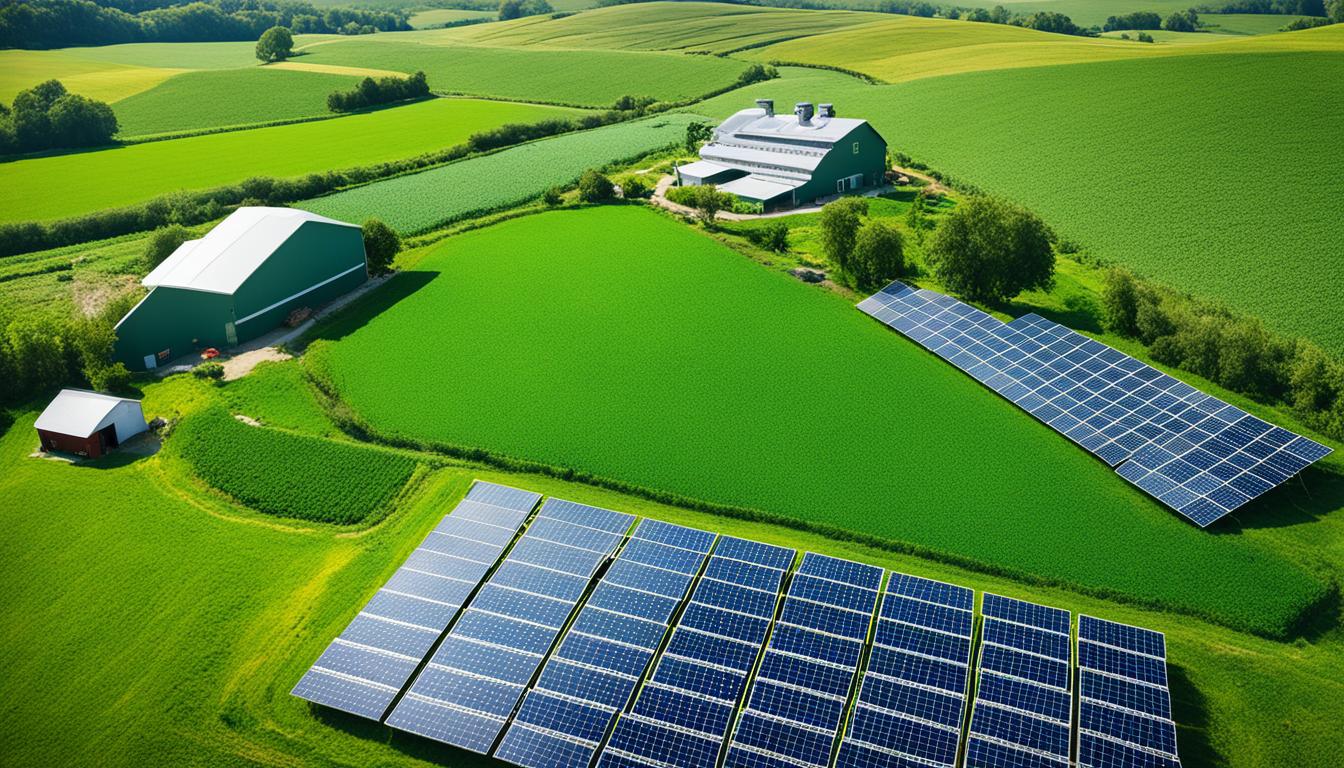
Did you know over 600 people joined the LEAF’s Annual Conference in 2024? It took place at the BNP Paribas UK Headquarters in London and online. There, people talked about farm management, caring for livestock and soil, all key for today’s farming. Experts from Tesco, the Allerton Project, and Cranfield University talked about green farming too.
Agriculture, especially in the High Plains/Great Plains of the US, is very important. Even with new tech, it’s hard to be more productive and competitive. It’s important to look at each farm’s special needs to better what they grow. Smart tech like GPS, drones, and sensors give minute by minute updates on how crops and soil are doing. This helps farms use sustainable methods more.
Doing farming sustainably helps the environment by saving water and soil. It can also help make more money. Using systems like FieldNET can save water and make crops healthier. Government help, like subsidies, is crucial for pushing for greener farming and new tech. This means more farmers can use eco-friendly methods.
Sustainable farming is very important in today’s world. The world’s population is set to reach nearly ten billion by 2050. This means we need new, sustainable ways to grow food. We’ll look at how these methods help our planet, economy, and food supply over time.
Sustainable farming helps keep our planet healthy. It looks after the soil, saves water, and uses less harmful chemicals. Farming in an eco-friendly way and using organic methods keep the soil rich and save water. This protects our environment for future generations. Also, special farming for the climate fights climate change by cutting down on greenhouse gases and storing carbon.
Sustainable farming boosts the economy too. It helps over one billion people who work in farming by making their businesses stronger. By using less, like water and chemicals, costs are lower but the quality of what’s grown is better. This means everyone can get affordable, healthy food. It also makes farmers more money and keeps the economy strong.
The ability to farm well for years is very important. Sustainable methods keep nature in balance and use resources wisely. By farming in ways that protect the soil and improve it, we can keep growing food well. This makes food supplies stable and strong for the future. Education is crucial too. It helps farmers learn how to use these methods for their benefit.
Using eco-friendly practices is key for sustainable farming. It’s important to use organic cultivation techniques and sustainable water management strategies. These help with regenerative farming methods.
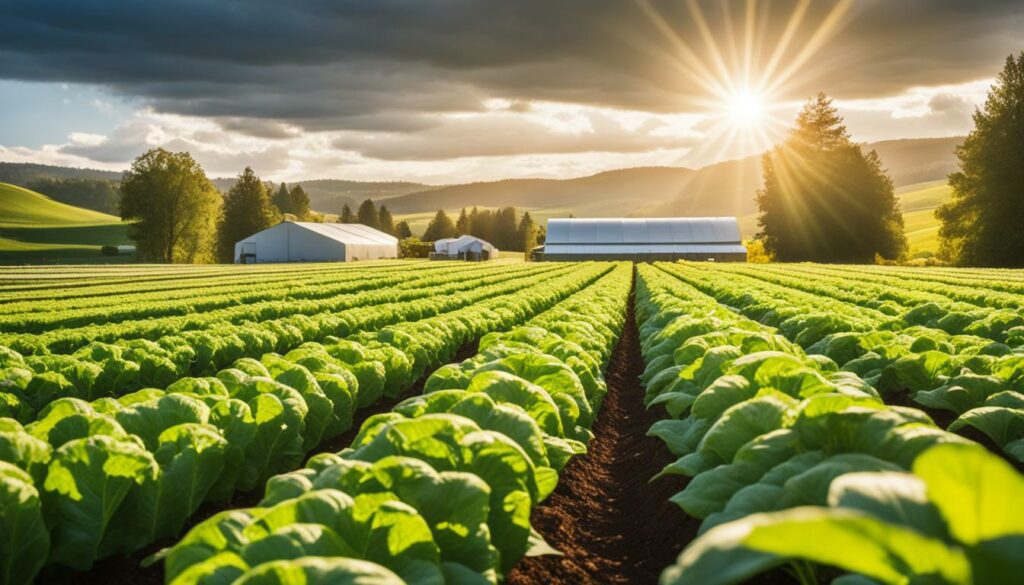
Organic farming avoids synthetic pesticides and fertilisers. It uses natural options instead. For example, covering fields with crops like clover or rye can cut erosion by 40%. It also means less need for herbicides.
Farms using these methods have decreased their use of chemical pesticides by 35%. This is due to integrated pest management.
| Practices | Benefits |
|---|---|
| Cover Crops | Reduce erosion by up to 40% |
| Integrated Pest Management | 35% decrease in chemical pesticide use |
| Multiyear Crop Rotations | Increase soil health by 25% |
| No-Till Methods | 60% reduction in soil loss |
Using water wisely is also vital for farming. Techniques like pivot irrigation can significantly reduce water waste. Automated systems with sensors make water use even more efficient.
When farms manage water and land as a whole, they produce less nutrient pollution and erosion. This leads to better water conservation and helps wildlife.
In summary, eco-friendly farming is full of new ideas to keep the land healthy and profitable. It’s all about using organic cultivation techniques and regenerative farming methods. To complete this, using sustainable water management strategies is key. These improve the future of farming.
The need for food is growing fast. By 2050, the United Nations predicts it will rise by 70%. To meet these future agricultural needs, we have to turn to green farming technology. This tech is crucial for using resources well and increasing crop yields.
GPS and drones are changing the face of modern farming. They let farmers monitor their crops in real time. This way, they can get deep insights into crop health and the environment.
With precision agriculture tools, like GPS-guided vehicles and satellite crop tracking, inputs are used better. This also makes farm management more efficient. Drones take this a step further, by offering aerial views. This shows farmers detailed plant health, soil, and water needs.
Automation and AI are making farming processes smarter and more efficient. They help with planting, watering, and harvesting. By using AI, farmers can make quick, effective decisions. This cuts down on waste and improves how crops grow.
One example is automated irrigation that adjusts water use in real time. It does this based on data from sensors. And, with advanced technology, farms can keep a close eye on their vehicles and fuel use. This helps make farming operations more sustainable.
Regenerative farming methods are key for better soil health. These ancient methods, long used by native people, came before today’s farming. They involve things like cover crops, crop rotation, and adding organic matter to the soil. This approach supports the land and brings both environmental and financial benefits.
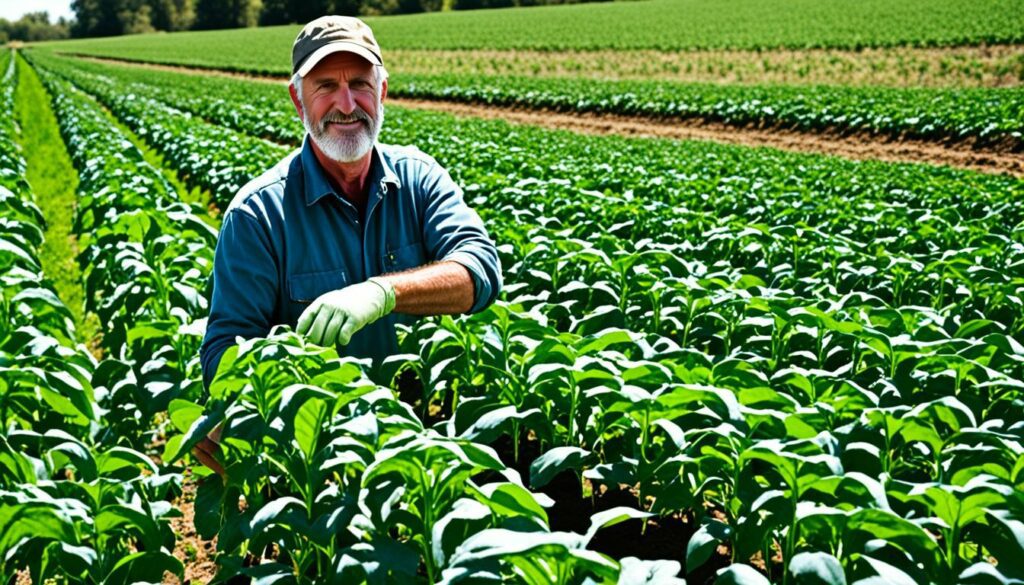
Cover crops are vital, with plants like legumes, winter wheat, and clover. They help keep nitrogen levels steady and boost the soil’s organic matter. These plants fight against soil erosion, which is a big problem in usual farming. They also make the soil healthier, increase the number of different plants and animals, and help the soil keep water better.
Rotating crops is important for soil health. It stops harmful bugs and diseases from building up and helps the soil absorb nutrients better. This way of farming doesn’t need as many man-made fertilisers. It also increases crop production without using a lot of chemicals.
During the Dust Bowl in the 1930s, tons of fertile land lost its value. If people had used crop rotation then, much of that disaster could have been avoided.
Adding compost and soil changes is also great for the land. These include things like PrairieFood, which make the soil more nutritious. This means farmers don’t need to use as many chemical products. Overall, this type of farming keeps the land healthy, saves money, and brings communities closer together.
So, regenerative farming is a very positive way to take care of the soil. It focuses on cover crops, rotating crops, and adding compost. This leads to healthier soil and a more sustainable future in farming.
Managing our water well is key for sustainable farming. Agriculture uses over 80% of our water, showing why new ideas are needed. These new methods aim to use and save water better.
Pivot systems are smart and work well. They give water exactly where different crops need it most. Farmers can use water wisely against dry spells and urban growth. This smart use of water helps crops and prevents pollution.
Reusing and recycling water is now vital. It helps save fresh water and supports the environment. For instance, collecting rainwater means less water is needed from outside. This method also saves money and helps agriculture to grow sustainably.
Automation can also make water use more sustainable. It gives the exact amount of water needed to each crop. This technology uses real-time data to water more intelligently, reducing waste and improving efficiency. Groups like the Irrigation Innovation Consortium are speeding up these helpful technologies.
Together, these strategies tackle both current farming needs and future challenges. Implementing pivot systems, recycling water, and using smart tech, we ensure our farms stay productive and strong.
| Management Strategies | Key Benefits |
|---|---|
| Pivot Irrigation Systems | Optimised water application, adaptation to crop needs, reduced nutrient runoff |
| Water Reuse and Recycling | Conservation of fresh water supplies, cost-effective farming, long-term sustainability |
| Irrigation Automation Technology | Precise water distribution, improved resource efficiency, real-time soil moisture monitoring |
Climate-smart agriculture helps us deal with more food needs and climate change. It cuts down on the carbon footprint. It makes farming more sustainable and resilient.
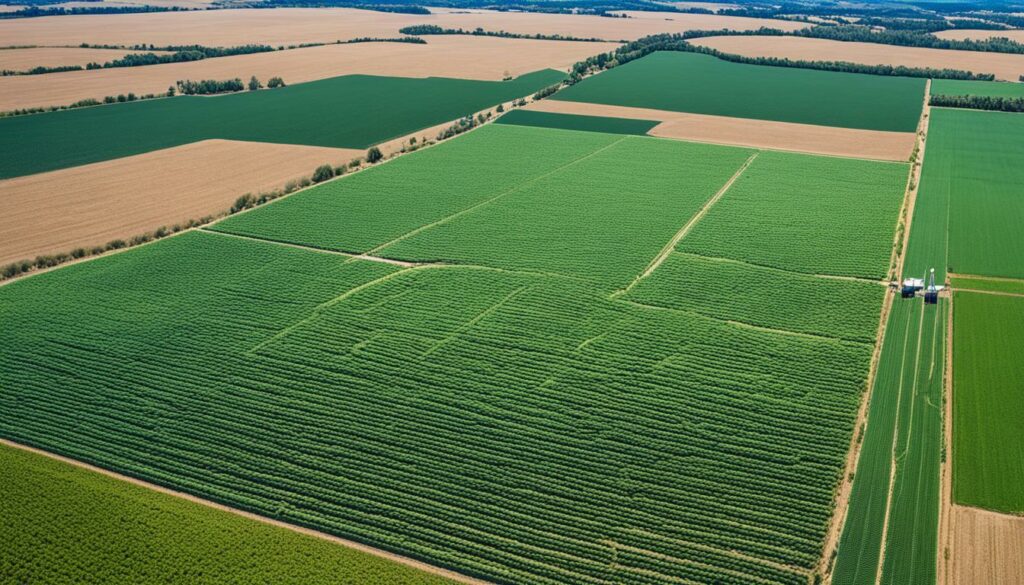
Agriculture’s ways create lots of emissions, up to a third of the total. It releases a lot of methane and causes the loss of many animal and plant species. To grow crops, we cut down forests which makes more carbon dioxide.
Using methods like keeping the soil covered and not tilling it can trap more carbon in the earth. Adding things to the soil can boost its health and keep water cleaner. Anaerobic digesters are machines that can cut back on greenhouse gases by dealing with animal waste the right way.
Using water wisely in farming is very important. Farming uses most of the fresh water we have. So, we need to use the latest methods to irrigate better. Things like precise watering and collecting rainwater can make a big difference.
Pivot irrigation systems apply water exactly where it’s needed, saving water and helping crops grow. Adding sensors to check the moisture in the soil can also help. This means water is only used when, and where, it’s really needed.
The World Bank now spends nearly $3 billion a year on Climate-Smart Agriculture (CSA). This supports many countries like China, Kenya, and Jordan. It shows the whole world is working together to fight climate change and grow food the right way.
By using climate-smart farming, we lower emissions and use water better. This helps us farm in ways that meet our food needs in the future.
In today’s farming, using low carbon footprint methods is key. It helps to reduce harm to the environment. We do this by using renewable energy and eco-friendly farming methods. These steps cut the amount of greenhouse gases farms produce.
Using renewable energy is big for cutting the carbon footprint of farming. Farmers now use solar, wind, and biomass energy. These sources help in using less fossil fuel. Solar panels and wind turbines can power many farm activities.
In California, farming causes over 50% of the state’s greenhouse gas emissions. A lot comes from cows producing methane. But, using renewable energy can lower these emissions. It also makes farms more productive. New ways to water crops, like drip irrigation, save water and energy.
Sustainable agricultural techniques are crucial for fighting climate change. They help make soil healthier and cut carbon. For instance, organic farming keeps the earth, water, and food clean. It also boosts soil’s well-being. Using energy well and cutting back on fossil fuels is another key part of eco-friendly farming.
The global COVID-19 pandemic impacted all parts of society. It disrupted production and travel worldwide. The food industry, in particular, faced major ethical trials. These challenges made the need for sustainable and ethical food production clear. Fair trade methods and community-supported agriculture are key. They ensure our food systems are fair and open.
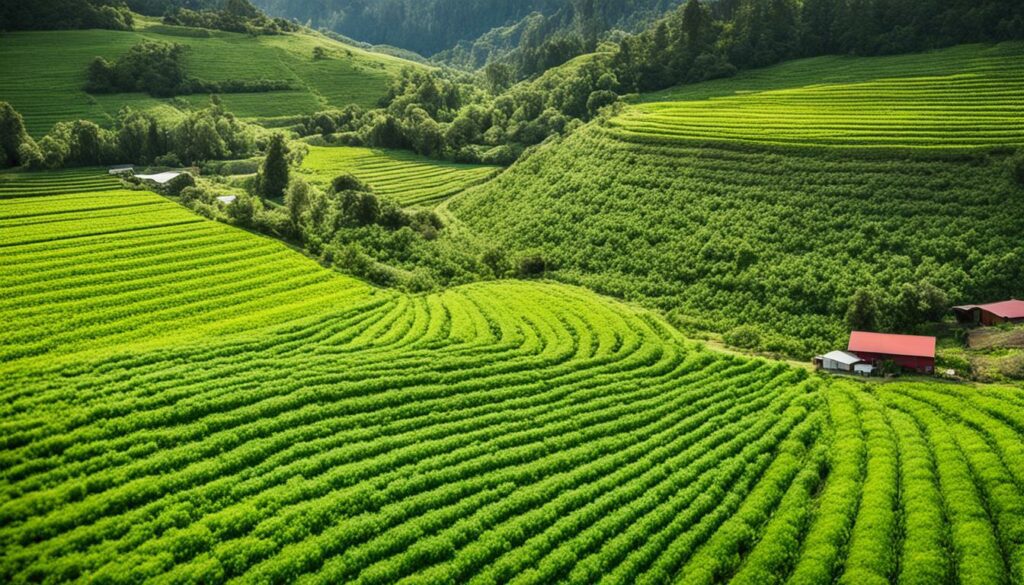
Fair trade practices aim to provide better trade terms and encourage sustainable farming. They make sure producers and workers get fair wages and work in safe conditions. These practices also help communities grow. During the pandemic, more people started looking for ethical food options. They wanted to know where their food came from and how it was made. The interest in fair trade has grown because of this need for openness and responsibility.
This change has helped farmers deal with economic problems. It has also ensured their jobs are safe. Fair trade is about fairness and honesty in all stages of food production. This includes sourcing and making food. It supports farmers and helps them keep going strong.
Community-supported agriculture (CSA) projects grew a lot during the pandemic. People started cooking more at home and buying local food. This was because they couldn’t travel far. CSAs acted as a strong link between local farmers and buyers. They encouraged ethical food making and fair trade. They also helped local economies. By using clear supply chains and avoiding long travel for food, CSAs made sure communities got fresh, ethical, and sustainable food.
CSAs also helped make consumers know more about food production. This hands-on knowledge has made people want food systems that are truthful and fair. Studies show more and more people prefer food that is made responsibly. This highlights how important community-supported agriculture is for the future of food.
The new agroecology policy by Fairtrade focuses on using less water, reducing greenhouse gases, and finding new income streams. It shows fair trade’s dedication to ethical and sustainable farming.
Choosing ethical food through fair trade and community-supported agriculture leads to a fair, clear, and strong food system. This way of working helps with current financial issues and future eco goals. It builds a base for a kinder and more ethical global food community.
Every farm is unique. This means farming methods should be chosen carefully to make the most of each farm’s nature. By using special techniques, farmers can improve what their farm produces. They can also make sure their methods look after the land well.
The NOP, started by the USDA in 2002, set rules for organic food making. These rules help us see how farms are different. Sustainable farming, explained by the USDA in 2015, is about using resources well. It shows that special methods are important.
Regenerative farming combines organic and sustainable ways. This mix helps manage different farm types. It uses things like cover crops and moving animals around to keep the soil healthy. These ways can be changed to fit the needs of each farm.
Source Farms use organic and regenerative ways. They follow USDA tips and work to keep the soil rich. They aim to create farming systems that meet each farm’s needs well.
In farming, it’s key to know the soil, weather, and what crops need on each farm. This detail helps in choosing the right crops and technology. This makes sure the ways used not only fit but also make the farm better.
| Farm Type | Unique Characteristics | Tailored Approaches | Diversified Practices |
|---|---|---|---|
| Organic Farms | Ban on synthetic inputs | Use of organic seeds and natural amendments | Composting, Rotational Grazing |
| Sustainable Farms | Focus on nonrenewable resource efficiency | Conservation practices, reduced soil disturbance | Cover Crops, Crop Rotation |
| Regenerative Farms | Holistic land care practices | Integration of organic and sustainable methods | Agroforestry, Habitat Conservation |
Knowing and using each farm’s special traits with the right farming ways can make agriculture strong and lasting. It’s these personalised methods that help farming be resilient and ready for the future. They encourage new ideas and the ability to change.
The government helps farmers move to eco-friendly ways through financial support. This includes funds from both federal and state levels. It makes it easier for farm owners to choose methods that are good for nature and their business.
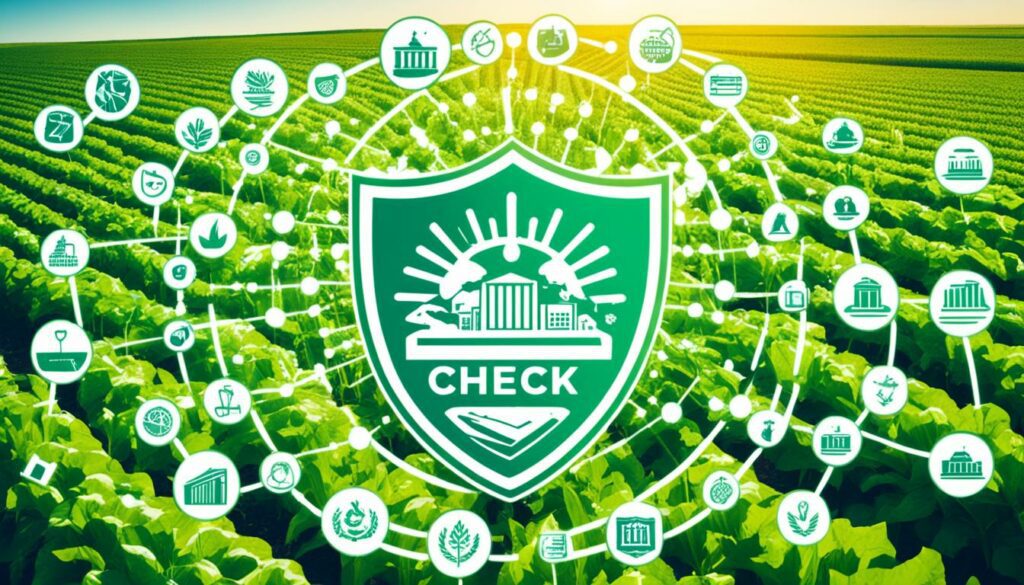
In the United States, the agriculture sector benefits from special schemes to encourage sustainable farming. Some notable programs are:
Government support is key for farmers looking to be sustainable. This aid allows them to choose environmentally friendly methods. It also helps them afford green technologies.
For example, support is offered for green practices like IPM. This method cuts down on economic and health risks. It also benefits the environment.
Other supported activities include soil conservation. Techniques like less tillage and strip cropping help prevent soil erosion. Water conservation is encouraged too. By planting buffer strips, farmers protect water quality.
Cover crops, such as rye or clover, help the soil and control weeds. Diverse crops and landscapes reduce risks and protect wildlife and soil. Nutrient management, via manure and plant nutrients, improves soil quality.
Tree-crop integration and direct marketing also get backing. It helps farmers sell directly through markets, CSA schemes, and roadside stands.
These aids make sustainable farming methods more achievable. It ‘ s good for the farmers and the agricultural sector as a whole. It leads to a stronger and greener agricultural sector nationwide.
Soil health is key to successful sustainable farming. It’s vital for producing food and saving our ecosystems. Healthy soil aids in nutrient cycling, water movement, and managing climate impacts. This makes it crucial for sustainable farming.
It’s essential to check soil fertility for good soil health. We look at things like soil life and tiny organisms to measure it. A study found more soil life in organic fields, showing the benefits of organic farming.
This soil life can signal how well crops will grow. It also affects fruit quality and how the soil holds water. So, knowing about soil life lets farmers better manage their land.
Using natural fertilisers, such as compost, is important. It helps keep the land rich and supports healthy soil life. Techniques like strip tillage can improve soil even more by increasing fungi.
Studies show organic farms have more earthworms. This is because they use natural fertilisers. The presence of earthworms is a sign of good soil.
Cover crops are also great for soil. A video by SARE shows they make soil better for planting, keep water clean, and fight pests. In some places, farmers are trying special plants that naturally fix the soil.
One project in Colorado involves farmers working together for healthy soil. By adding natural material to the soil, they trap carbon and make the land more fertile. These efforts make farming last longer and keep the environment healthy.
| Practice | Impact on Soil Health |
|---|---|
| Organic Farming | Higher microbial biomass carbon, enhanced biota, increased earthworm abundance |
| Cover Crops | Improved soil structure, water quality protection, pest suppression, profitability boost |
| Natural Fertilisers | Enhanced soil structure, increased fungal activity, support for soil biota |
| Conservation Tillage | Increased fungal abundance and activity, reduced soil disturbance |
To have successful farming systems, we must care for the soil. Natural fertilisers and soil checks are important. They help us farm well while looking after the environment.
Investing in post-harvest infrastructure boosts agricultural food quality and cuts minimizes post-harvest losses. Bad storage and handling can lead to big losses. This affects how much money both small and big farmers make. The FAO says, better infrastructure might have cut down the $118 million East Africa spent on locusts. Quality solutions like GrainPro’s Cocoon and Solar Bubble Dryer help keep food fresh.
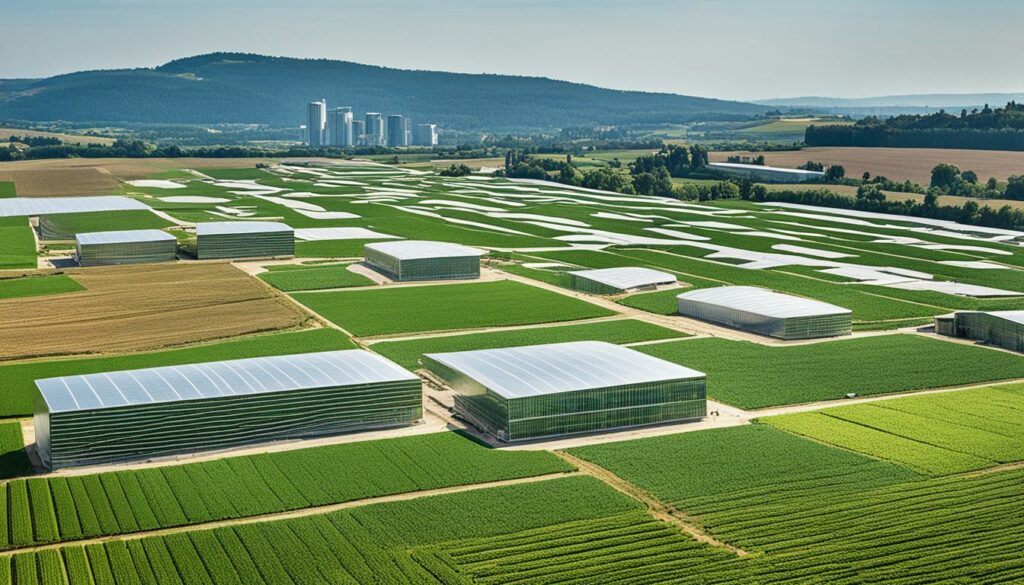
Knowing about good post-harvest set-ups is key. With more people to feed by 2050, we need 70% more food. So, cutting waste is very important. If we handle food better, we also help the planet. This means less pollution and waste from rotting food. Right now, farming causes 30% of the world’s pollution. So, good care after harvesting is really urgent.
Cooling and special packaging can make food last longer and sell better. This could add up to $0.70 per kilo in extra profit. Most farms are run by small people, who also struggle with hunger a lot. Better post-harvest places can really help them by making food last longer and taste better.
| Challenge | Solution | Benefit |
|---|---|---|
| Inadequate Storage | GrainPro Cocoon, Solar Bubble Dryer | Preserves product quality |
| High Post-Harvest Losses | Proper Handling Systems | Reduces wastage |
| Poor Market Access | Informed Market Information | Maximises profitability |
So, making post-harvest places better isn’t just about less waste. It’s about making food better and more valuable. This helps make food systems better for everyone, all around the world.
Sustainable farming has never been more crucial. It is key for future food supply and keeping our planet healthy. Thanks to advancements since World War II, farmers can now grow more food with less effort.
This shift to sustainable farming began about 40 years ago. It focuses on using nature wisely, making profit, and being fair to everyone. These goals help create a well-rounded approach to farming today.
Protecting the land and our resources for the long haul is vital. It means knowing how to work with nature and our food systems without harming them. Being able to change and cope with different situations is very important.
As the world’s population grows, we need to find ways to produce more food. But this must be done without hurting the Earth. Sustainable farming plays a big role in this important task.
Sustainable farming is all about using local resources well and caring for the land. It focuses on smarter water use and using natural ways to feed plants. This helps to grow better, healthier food. It also helps local economies and small farmers. These methods are good for fairness and making sure the food system is right.
The answer to a good future in farming is to use the Earth wisely. This means using clever, green tech and supporting honest food making. Taking care of water, the soil, and the food after it’s grown helps our farms be strong and do well into the future.
Sustainable farming helps the environment, boosts the economy, and keeps agriculture stable. It saves the soil, uses less water, and avoids harmful chemicals.
Eco-friendly farming keeps nature in balance. It avoids synthetic chemicals, saves water, and makes the soil healthier.
Green farming uses high-tech tools like GPS and drones. They give farmers data to grow crops better while saving resources and cutting waste.
Regenerative farming makes soil better by using cover crops and rotating plants. It adds compost and enriches the earth with essential nutrients.
Water is vital for sustainable farming. Smart irrigation and recycling water help save this precious resource and keep farming sustainable.
Climate-smart techniques reduce carbon footprints and adapt to changing weather. They help farming stay productive and strong, even with climate challenges.
Using solar and wind power in farming cuts down on pollution. It supports sustainable practices and helps fight climate change.
Ethical food comes from fair and transparent methods. It includes supporting fair trade and community agriculture to make sure everyone benefits.
Each farm is unique and needs its own farming plan. This leads to better crops and a healthier environment.
The government helps farmers go green with subsidies. This makes eco-friendly farming more affordable, benefitting the planet and farmers.
Healthy soil is key for good crops. By testing the soil and using natural fertilisers, farmers keep the land rich and their crops strong.
Keeping crops after harvest helps prevent waste and keeps their quality. Good storage, handling, and market knowledge mean more profit for farmers and a better planet.